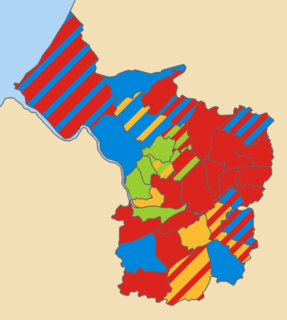Elections to Oxford City Council were held on 10 June 2004. The council is elected by halves, so one seat in each ward was up for election. Labour lost majority control of the council but remained in minority administration. Overall turnout was 37.6%, with the lowest turnout (26.5%) in Carfax ward and the highest (49.5%) in Wolvercote.
Elections for Oxford City Council were held on Thursday 4 May 2006. As Oxford City Council is elected by halves, one seat in each of the 24 wards was up for election. The exception was St Clement's, where both seats were up for election as a by-election for the other seat was held on the same day. Therefore, 25 of the 48 seats on the Council were up for election. Overall turnout was 35.8%, down from 37.6% in 2004. The lowest turnout (24.9%) was in Carfax ward and the highest (49.6%) in Marston.

Elections for London Borough of Redbridge Council were held on Thursday 4 May 2006. The whole council was up for election. Redbridge is split up into 21 wards, each electing 3 councilors, so a total of 63 seats were up for election.
Elections to the Borough Council in Slough, England, were held on 3 May 2007. One third of the council was up for election. This was the 122nd Slough general local authority election since Slough became a local government unit in 1863.
Elections for Oxford City Council were held on Thursday 1 May 2008. As Oxford City Council is elected by halves, one seat in each of the 24 wards is up for election.

Elections to Calderdale Metropolitan Borough Council were held on 3 May 2007 with the exception of the Warley ward which was postponed until 14 June 2007 due to the sudden death of one of the candidates. One third of the council was up for election and the council stayed under no overall control with a minority Conservative administration. The total turnout of the election was 38.01%. The winning candidate in each ward is highlighted in bold.
Elections for Oxford City Council were held on Thursday 6 May 2010. As Oxford City Council is elected by halves, one seat in each of the 24 wards was up for election.

Elections for Cambridge City Council were held on Thursday 5 May 2011. As the council is elected by thirds, one seat in each of the wards was up for election, with the exception of Cherry Hinton ward where two seats were up for election due to the early retirement of Councillor Stuart Newbold. The vote took place alongside the United Kingdom Alternative Vote referendum, 2011 and a Cambridgeshire County Council by-election for Arbury ward.
The 2011 council elections in Guildford saw the Conservatives retain control over Guildford Borough Council with an increased majority of 20 seats. Full results for each ward can be found at Guildford Council election, full results, 2011.

Sheffield City Council elections took place on Thursday 3 May 2012 as part of the United Kingdom local elections, 2012.
Elections for Oxford City Council were held on Thursday 3 May 2012. As Oxford City Council is elected by halves, one seat in each of the 24 wards is up for election.
Elections to the Charnwood Borough Council took place on 5 May 2011, in line with other local elections in the United Kingdom. A total of 52 councillors were elected from 28 wards as the whole council was up for election.
The 2015 Guildford Borough Council election took place on 7 May 2015 to elect members of Guildford Borough Council in England as one of the 2015 local elections, held simultaneously with the General Election.

The 2016 Bristol City Council election took place on Thursday 5 May 2016, alongside nationwide local elections. Following a boundary review, the number of wards in the City was reduced to 34, with each electing one, two or three Councillors. The overall number of Councillors remained 70, with all seats are up for election at the same time. Elections would then be held every 4 years.

Elections to Mid Bedfordshire District Council were held in May 2007. These were the last elections to council, with all 53 seats being up for election. Councillors elected would serve a two-year term, expiring in 2009, when Mid Bedfordshire District Council was replaced by Central Bedfordshire Council. The Conservative Party retained overall control of the council, winning 37 of 53 seats on the council. The Conservatives won 8 seats unopposed, as did an Independent candidate in one ward.

Elections to Mid Bedfordshire District Council were held on 1 May 2003. All 53 seats were up for election. Councillors elected would serve a four-year term, expiring in 2007. The Conservative Party retained overall control of the council, winning 37 of 53 seats on the council. The Conservatives won 7 seats unopposed.

Elections to Mid Bedfordshire District Council were held on 6 May 1999. All 53 seats were up for election. The Conservative Party gained overall control of the council, increasing their number of seats from 22 to 34, whilst the Labour Party declined from having 20 seats in 1995 to 7.

Elections to Mid Bedfordshire District Council were held on 4 May 1995. All 53 seats were up for election.

Elections to Mid Bedfordshire District Council were held on 3 May 1979, on the same day as the general election, so turnout was higher than usual in district council elections for Mid Bedfordshire. All 53 seats were up for election.

The 2018 Leeds City Council election took place on 3 May 2018 to elect members of Leeds City Council in England. They were held on the same day as other local elections across England and the rest of the UK.









